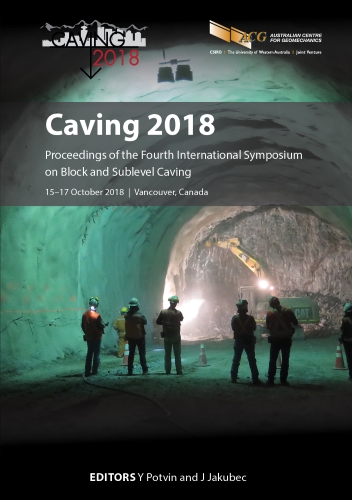Integrated simulation and optimisation tools for production scheduling using finite element analysis caving geomechanics simulation coupled with 3D cellular automata

|
Authors: Arndt, S; Bui, T; Diering, T; Austen, I; Hocking, R |
DOI https://doi.org/10.36487/ACG_rep/1815_16_Arndt
Cite As:
Arndt, S, Bui, T, Diering, T, Austen, I & Hocking, R 2018, 'Integrated simulation and optimisation tools for production scheduling using finite element analysis caving geomechanics simulation coupled with 3D cellular automata', in Y Potvin & J Jakubec (eds), Caving 2018: Proceedings of the Fourth International Symposium on Block and Sublevel Caving, Australian Centre for Geomechanics, Perth, pp. 247-260, https://doi.org/10.36487/ACG_rep/1815_16_Arndt
Abstract:
Key challenges integrating caving geomechanics simulation into mine planning processes start with the considerable effort to build realistic models and to map production schedules and cave back geometries into the simulation. Currently, calibrating parameters for the complex failure mechanisms that define the interface (cave back, possible airgap, muck pile) between solid and flow domain can be extremely time consuming. This also often requires a high level of expertise in modelling. This work investigates the numerical efficiency of automated mesh and model building strategies and advantages of using high-performance computing on regular fine grids for non-linear finite element simulation. This allows direct mapping of cellular automaton results, and in return, predictions of rock mass failure without loss of accuracy at a higher frequency, maximising the use of information available from calibrated flow models for production scheduling. An important goal for such models must be the ability to simulate cave growth in complex geological settings and replicate realistic behaviour for relevant benchmark problems that reflect industry experience in block caving. These automated processes will not just accelerate the cave modelling processes and reduce manual processing time but also allow use of the full simulation cycle in case studies, sensitivity analysis and optimisation in an environment of uncertainty and constant changes to the available data. Integrated simulation and optimisation tools significantly improve understanding of realistic geomechanics behaviour driven by the inherent characteristics of the rock mass and structural geological setting, by the extraction strategy and by other engineering decisions (interaction with underground infrastructure). This greater level of understanding reflects in key performance indicators related to safety, revenue maximisation (strategy on how best to exploit the mineral resource), and operation excellence (productivity).
Keywords: caving geomechanics, cellular automata, finite element analysis, simulation, optimisation
References:
Arndt, S 2009, ‘Realistic simulation accelerates safety evaluation of mine designs’, INSIGHTS: Dassault Systèmes Realistic Simulation Magazine, Dassault Systèmes Simulia Corp., Providence.
Arndt, S, Beck, D, Reusch, F, Thin, I, Stone, C, Heap, M & Tyler, D 2007, ‘Deep and high stress mining–deformation and seismicity’, Proceedings of the 20th Annual International Abaqus Users Conference, Dassault Systèmes, Paris.
Beck, D, Arndt, S, Thin, I, Stone, C & Butcher, R 2006, ‘A conceptual sequence for a block cave in an extreme stress and deformation environment’, in J Hadjigeorgiou & M Grenon (eds), Proceedings of The Third International Seminar on Deep and High Stress Mining, Université Laval, Quebec City, Section 11.
Cumming-Potvin, D, Wesseloo, J, Jacobsz, SW & Kearsley, E 2016, ‘Fracture banding in caving mines’, Journal of the Southern African Institute of Mining and Metallurgy, vol. 116, no. 8, pp. 753–761.
Dassault Systèmes 2018a, Abaqus, computer software, Dassault Systèmes, Paris, https://www.3ds.com/products-services/simulia/products/abaqus/
Dassault Systèmes 2018b, PCBC, computer software, Dassault Systèmes, Paris, https://www.3ds.com/products-services/geovia/products/pcbc/
Diering, T 2007, ‘Template mixing: a depletion engine for block cave scheduling’, Proceedings of the 33rd International Symposium on Application of Computers and Operations Research in Mineral Industry, Gecamin, Santiago, pp. 24–27.
Diering, T, Richter, O & Villa, D 2010, ‘Block cave production scheduling using PCBC’, Proceedings of the SME 2010 Annual Meeting, Society for Mining, Metallurgy & Exploration, Englewood, pp. 455–467.
Dunstan, G 2016, ‘The truth is stranger than fiction – the story of Ridgeway gold mine’, Proceedings of MassMin 2016, The Australasian Institute of Mining and Metallurgy, Melbourne, pp. 19–30.
Duplancic, P 2001, Characterization of Caving Mechanisms Through Analysis of Stress and Seismicity, PhD thesis, The University of Western Australia.
Lachenicht, R 2011, ‘Ground support practices at Ridgeway’, in Y Potvin (ed.), Advanced Ground Support in Underground Mining Seminar, Australian Centre for Geomechanics, Perth.
Lett, JL, Brunton, I, Capes, GW, Jäger, A, Mobilio, B, Rachocki, J, Sharrock, GB & Secheny, M 2016, ‘Undercutting to surface breakthrough – Cadia East Panel Cave (Stage 1)’, Proceedings of MassMin 2016, The Australasian Institute of Mining and Metallurgy, Melbourne, pp. 65–81.
Lowther, RJ, Olivier, L, Lett, LJ & Brunton, I 2016, ‘Implementation of a surface-based hydraulic fracturing program to successfully propagate a large cave through hard, competent near-surface rock masses to achieve breakthrough’, Proceedings of MassMin 2016, The Australasian Institute of Mining and Metallurgy, Melbourne, pp. 83–96.
Oliveira, D & Pells, P 2014, ‘Revisiting the applicability of voussoir beam theory for tunnel design in Sydney’, Australian Geomechanics, vol. 49, no. 3, pp. 29–44.
Preisig, G, Eberhardt, E, Gischig, V, Roche, V, Baan, M, Valley, B, Kaiser, P, Duff, D & Lowther, R 2015, ‘Development of connected permeability in massive crystalline rocks through hydraulic fracture propagation and shearing accompanying fluid injection’, Geofluids, vol. 15, no. 1–2, pp. 321–337.
Zoback, MD 2007, Reservoir Geomechanics, Cambridge University Press, Cambridge.
© Copyright 2025, Australian Centre for Geomechanics (ACG), The University of Western Australia. All rights reserved.
View copyright/legal information
Please direct any queries or error reports to repository-acg@uwa.edu.au
View copyright/legal information
Please direct any queries or error reports to repository-acg@uwa.edu.au
